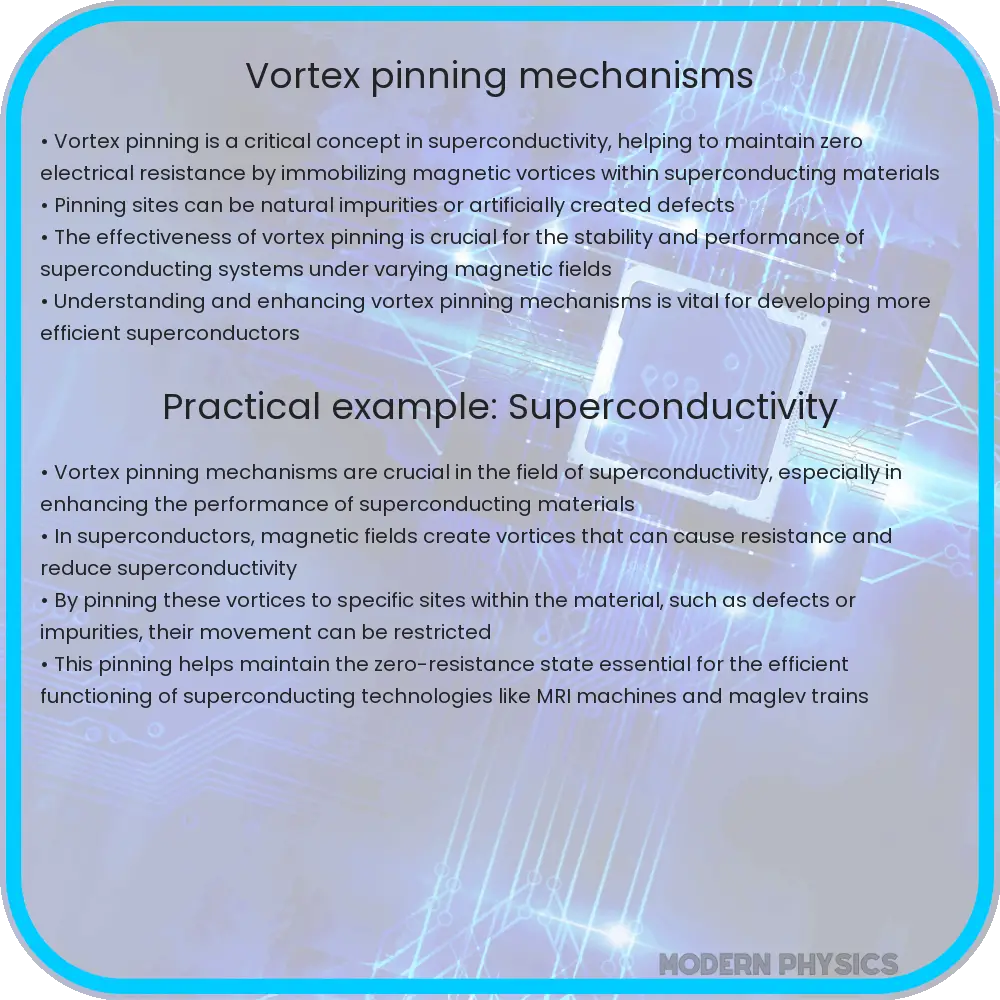Explore the critical role of vortex pinning in superconductors, enhancing efficiency through innovative types, optimization, and future challenges.

Vortex Pinning in Superconductors: Enhancing Efficiency
Superconductors have the unique ability to conduct electricity without resistance, making them highly valuable in various technological applications, from magnetic resonance imaging (MRI) machines to high-speed trains. However, their efficiency can be significantly affected by magnetic vortices, which are formed when a type II superconductor is placed in a magnetic field exceeding its lower critical field (Hc1) but less than its upper critical field (Hc2). These vortices, consisting of normal-conducting cores surrounded by circulating supercurrents, can move under the influence of Lorentz forces, leading to energy dissipation and a loss of superconductivity.
To counteract this issue, vortex pinning is employed. Vortex pinning involves anchoring the vortices in place within the superconducting material, thereby maintaining zero electrical resistance. This is achieved by introducing defects or inhomogeneities in the superconductor, which can trap or ‘pin’ the vortices, preventing their movement.
Types of Vortex Pinning
Vortex pinning can be categorized based on the nature of the defects used to trap the vortices:
- Point Pinning: Involves small defects such as vacancies, interstitial atoms, or nanoscale inclusions. These point defects can effectively pin vortices but may require a high density to be effective across the superconductor.
- Line Pinning: Involves elongated defects such as dislocations or columnar defects created by heavy ion irradiation. These are more effective than point pinning as they provide a larger area to trap vortices.
- Surface Pinning: Involves interfaces or grain boundaries within the superconductor. Surface pinning can be particularly effective when the boundaries are aligned perpendicular to the applied magnetic field.
Each type of pinning center has its advantages and limitations, and the choice depends on the superconducting material and its intended application.
Innovations in Vortex Pinning
Recent advancements in superconductor technology have focused on enhancing vortex pinning to improve efficiency. Innovations include the engineering of nanostructured superconductors, which introduce a controlled array of defects to optimize pinning landscapes and increase critical currents. Additionally, researchers are exploring the use of artificial intelligence to predict and design optimal pinning sites, aiming for superconductors that can operate efficiently under higher magnetic fields and temperatures.
Optimizing Superconductor Performance through Vortex Pinning
The optimization of superconductor performance through vortex pinning is not just a matter of selecting the right type of pinning center; it involves a comprehensive understanding of the interplay between the superconducting material, the pinning structures, and the operational environment. Advanced fabrication techniques, such as chemical vapor deposition (CVD), pulsed laser deposition (PLD), and molecular beam epitaxy (MBE), have enabled the creation of superconductors with precisely controlled microstructures. This precise control allows for the tailored distribution and density of pinning centers, which can significantly enhance the superconductor’s critical current density (Jc).
Moreover, the development of hybrid pinning landscapes, which combine different types of pinning centers, has emerged as a promising strategy. By integrating point, line, and surface pinning in a single superconductor, researchers aim to create materials that maintain high performance across a broad range of magnetic fields and temperatures. This multi-scale pinning approach addresses the complex dynamics of vortex movement, offering a path to more reliable and efficient superconducting systems.
Challenges and Future Directions
Despite the progress in vortex pinning strategies, challenges remain. The introduction of pinning centers can sometimes lead to unwanted side effects, such as a reduction in the superconductor’s thermal conductivity or an increase in materials’ brittleness. Additionally, the optimal distribution and density of pinning centers can vary significantly depending on the application, requiring customized solutions for different superconducting technologies.
Future research in vortex pinning is likely to focus on the development of new materials and pinning mechanisms, as well as on the integration of superconductors into practical devices. The ongoing exploration of high-temperature superconductors (HTS) offers exciting possibilities for energy transmission, magnetic storage, and transportation systems. Moreover, the application of cutting-edge techniques, such as machine learning and nanotechnology, promises to further enhance the efficiency and applicability of superconductors.
Conclusion
Vortex pinning plays a crucial role in the practical application of superconductors, directly impacting their efficiency and utility. By understanding and manipulating the complex dynamics of magnetic vortices, scientists and engineers can significantly improve the performance of superconducting materials. Despite the challenges, the continuous innovation in vortex pinning techniques and superconducting materials research holds the promise of transforming a wide range of technologies, from electric power systems to quantum computers. As the field advances, the dream of widespread, efficient, and cost-effective superconducting applications moves ever closer to reality.
